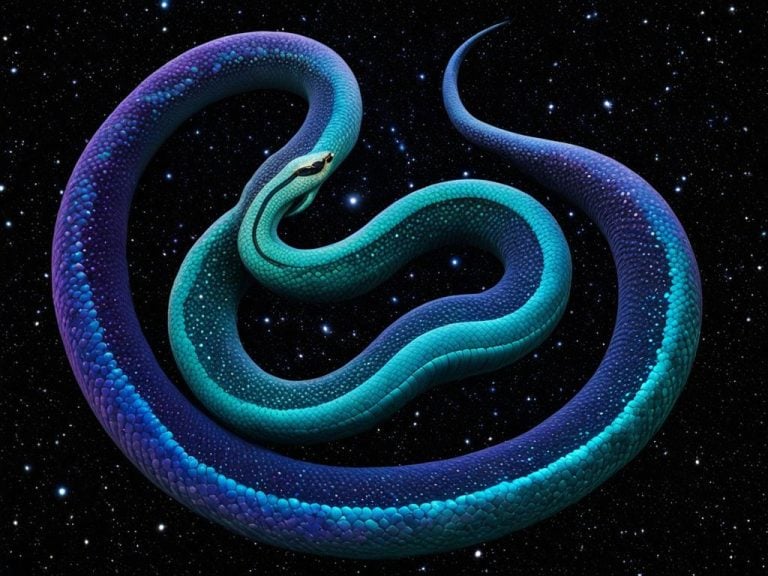Explore the Mysteries of Serpens Constellation
The Serpens Constellation holds a secret that shows us the universe’s wonders. It’s not just one space shape, but two. There’s the Serpens Caput, the head, and the Serpens Cauda, the tail. It sits near Hercules, Ophiuchus, Libra, and Scorpius. For centuries, it has amazed people who gaze at the stars.
Long ago in Mesopotamia, Serpens was thought to be about chaos and order. Its story is like a thrilling book. In Greek tales, Asclepius, the god of medicine, was taught by a serpent. The Serpens Constellation is part of this amazing tale.
Are you ready to travel through time and space? We’re about to explore the history, myths, and the beauty of Serpens. Get ready to see magical stars and hear fascinating stories. The cosmos is waiting to show you its wonders.

Key Takeaways:
- The Serpens Constellation consists of two parts: Serpens Caput (the head) and Serpens Cauda (the tail).
- Ancient Mesopotamian mythology associated Serpens with mythical creatures symbolizing chaos and order.
- According to Greek mythology, Serpens is linked to the legend of Asclepius, the god of medicine.
- Stargazing in the Constellation Serpens offers breathtaking marvels that will leave you spellbound.
- Naming a star in the Serpens Constellation is a unique and meaningful gift offered by International Star Registry.
A Historical Perspective
The Serpens constellation has a long history filled with stories. Many ancient cultures, from Mesopotamia to Greece, saw it as important. It was part of mythologies and beliefs about the sky.
Mesopotamia’s people, for example, thought the Serpens Constellation stood for both chaos and order. It featured in their stories about mythical beasts. It had deep meaning in their way of life.
In Greek myths, the Serpens Constellation is closely tied to Asclepius, the god of healing. They believed Asclepius was taught by a serpent. This story highlighted the constellation’s role in medicine and healing.
Today, people still find the Serpens Constellation amazing. Its role in history shows how it has always captured human imagination. The constellation’s stories have made it forever special.
Ancient Civilizations and Serpens
Many ancient cultures, like Mesopotamia and Greece, saw the Serpens Constellation’s value. It was key in their stories and beliefs about the stars. This shows how important it was to people everywhere.
- In Mesopotamia, the Serpens Constellation was associated with mythological creatures, representing chaos and order.
- The Ancient Greeks intertwined the Serpens Constellation with the legend of Asclepius, the god of medicine and healing, further enhancing its importance.
Mythological Significance
In Greek mythology, Serpens plays a big role, especially in Asclepius’ story. Asclepius was the healing and medicine god who could bring the dead back to life. Because of his special powers, Hades got upset. Hades didn’t like that Asclepius was changing the rules of life and death.
Hades talked to Zeus about his concerns. Zeus then decided to stop Asclepius by throwing a thunderbolt at him. But, Zeus later thought about Asclepius’ huge help to the world. So, he put Asclepius in the sky as a star sign called Ophiuchus. Serpens, the snake, is around Asclepius in the star sign. This shows their strong link between healing and wisdom, honoring Asclepius forever.
Stargazing Marvels
In the Serpens constellation, stargazers find many amazing sights. Messier 5 (M5) stands out, about 24,500 light-years from Earth. It’s a big part of the Milky Way, stretching over 165 light-years across.
M5 shines with stars that are incredibly old, possibly over 10 billion years. It tells us about the universe’s beginnings, being around 13 billion years old.
Ireland’s quiet, dark areas are perfect for seeing the stars without much light getting in the way. This makes it a top spot for watching wonders like M5.
Seeing M5 clearly needs a telescope or good binoculars. In Ireland, summer brings long, clear nights, perfect for this kind of stargazing.
Looking at M5 helps us understand how stars grow and the early parts of the universe. It’s like a window into the universe’s past, holding secrets from billions of years ago.
This study also helps in finding planets outside our solar system. By looking at the stars in M5, scientists might find new worlds.
So, Ireland’s dark, clear skies are a dream come true for exploring the stars and the universe’s beauty.

Links:
You can learn more about stargazing and constellations for each season here. Find more about M5 at this page. For beautiful videos of space, visit the NASA Scientific Visualization Studio here.
Celebrities
This constellation is a favorite among celebrities. Some celebrities that have their very own stars named in Serpens include Ozzy Osbourne, Kevin Bacon, and Ethan Embry.
Looking for a standout gift? International Star Registry lets you name a star in Serpens. It’s great for any big moments, like birthdays or showing love.
To pick a star in Serpens, go to starregistry.com. There, you can find different naming packages. It’s perfect for yourself or to give someone special.
The Serpens constellation is unique. It has a ‘head’ and a ‘tail,’ with Ophiuchus in between. It’s in the north and has nearby constellations like Hercules and Scorpius.
Learning about Serpens is like a trip through time and myth. It’s linked to stories about healing and balance, with Asclepius and tales of chaos and order.
Serpens is special because of its long history, links to famous people, and the mysteries it holds.
For more on Serpens, check out astrologyking.com and earthsky.org. You can also name a star in Serpens at starregistry.com.
Naming a Star in Serpens
Are you interested in the Serpens constellation? Naming a star there makes a special and lasting gift. International Star Registry offers this chance. You can buy a star for someone in Serpens for any occasion, showing love and a forever bond.
At International Star Registry, naming a star in Serpens is easy. This service lets you name a star after someone you love. They will get a personalized certificate that shows the star’s location. The star’s name is also recorded in their star catalog.
Naming a star is more than a gift. It shows your deep love. Imagine the happiness your loved one will feel knowing they have a star in Serpens. It’s a gift that they will treasure always.
Choosing International Star Registry means you get an official and real star name. They have been naming stars for over 45 years. People across the globe trust and love their service.
How to Name a Star
To name a star in the Serpens constellation, go to International Star Registry. Look at the star-naming packages they offer. This makes naming a star in Serpens both easy and meaningful.
First, choose the Serpens constellation. It could be for a birthday, anniversary, or a big achievement. This makes naming a star in Serpens special.
Next, give your star a special name. International Star Registry ensures your chosen name is officially recorded. You’ll also get a nice certificate with the star’s name and location. This makes your star’s name a part of astronomy history.
Viewing Serpens from Ireland
To see the Serpens constellation’s beauty, step outside at night. Ireland is a great place to do this. The ancient Serpens will amaze you in the Irish sky.
Summer is the best time to see Serpens. Irish summer nights are perfect for stargazing. The constellation shines highest in the warm sky then.
Looking for Serpens in Ireland? Start with the star Vega. It’s in the Lyra constellation and Serpens is east of it. You’ll see a line of stars forming a snake in the sky.
Find a dark place away from the city. Look up after your eyes adjust. The beautiful pattern of Serpens will appear among the stars. It will fill you with wonder.
Enjoy Ireland’s beautiful places for stargazing. Try a meadow, beach, or hill. They are perfect spots to feel the vastness above.
Being patient is important for stargazing. Let your eyes get used to the dark. Imagine the stories of Serpens as you watch. Have fun exploring the night sky!
Serpens Constellation Mythology
The Serpent constellation, called Serpens, is full of stories that have intrigued people for ages. In one Greek myth, young Hercules faced a deadly challenge. A snake was sent to kill him, but instead, he overcame it with his great strength. This brave act is one of the many heroic adventures he is famous for.
Serpens is also part of other Greek tales. One involves Apollo and a crow; Apollo turned the crow’s white feathers black because it had been disloyal. This constellation is closely tied to medicine too—its image is based on Asclepius, the god of healing. He carried a staff with a snake, a symbol still used by doctors today.
In Chinese culture, the stars of Serpens represent walls around the “Market of Heaven.” The idea of a celestial bazaar adds another layer of mystery and interest to this constellation.
For more on Serpens’ myths, check these links:
- For detailed myth coverage, see Ian Ridpath’s Serpens Mythology.
- To learn more about Serpens, visit Constellation Guide’s page.
- For a deep dive on Serpens’ tales, explore the Wikipedia page on it.
The fascinating myths of Serpens make it a must-see for anyone interested in stars and stories.

Continue reading
If you want to know more about the amazing stars in Serpens, keep reading to the next section.
Stars in the Serpens Constellation
The Serpens constellation is full of bright stars that amaze us. It includes Alpha Serpentis, known as Unukalhai, and Beta Serpentis, called Chow. These stars light up the night, making Serpens even more interesting.
In the spot called Serpens Caput, stars like Alpha and Beta Serpentis shine. Alpha is a big, yellow-orange star, and Beta is a small, bluish-white star. They stand out in the sky.
Serpens also has other cool things. The Eagle Nebula has tall gas and dust pillars where new stars form. The Omega Nebula, or Swan Nebula, shows pink and blue colors from gas and young stars. The Red Spider Nebula looks like a red web and it’s very detailed.
Exploring the Mysteries of Serpens
The Serpens constellation has a lot to see. It has big stars, beautiful nebulae, and a mysterious atmosphere. Looking at Serpens reminds us the universe is huge and amazing.
Conclusion
We end our look at the Serpens constellation, amazed by its mysteries and beauty. Serpens has a rich history and stories that have interested people for a long time.
But there’s more to the story. You can name a star in Serpens through International Star Registry. This unique gift is perfect for special occasions like birthdays or anniversaries.
So, why wait to start your star journey? Visit www.starregistry.com for a chance to name a star. With a few steps, you’ll make your mark in Serpens, forever in the night sky.
FAQ
What is the Serpens constellation?
The Serpens constellation is in two parts: Serpens Caput (the head) and Serpens Cauda (the tail). It’s found between Hercules, Ophiuchus, Libra, and Scorpius.
What is the historical significance of the Serpens constellation?
The Serpens constellation has a long and rich history from ancient times. It was linked to beasts that showed both chaos and order in Mesopotamian myths.
What is the mythological significance of the Serpens constellation?
Asclepius, the Greek god of medicine, is connected to Serpens. He gained his healing skills from a snake.
What is the mythology associated with the Serpens constellation?
Serpens was a snake sent to kill a baby Hercules. He beat it, a brave act. Serpens is also linked to Asclepius, the god of medicine, and tales of Apollo and a crow.
Can you summarize the allure of the Serpens constellation?
The Serpens constellation impresses with its story, myths, and sights. Naming a star there means a lasting bond in the sky.
Source Links
- M5 Globular Cluster in Serpens and The Mystery of The Ruby Eyes – https://rogerivester.com/2016/06/26/m5-globular-cluster-in-serpens/
- Serpens – https://www.starregistry.com/constellation-name/
